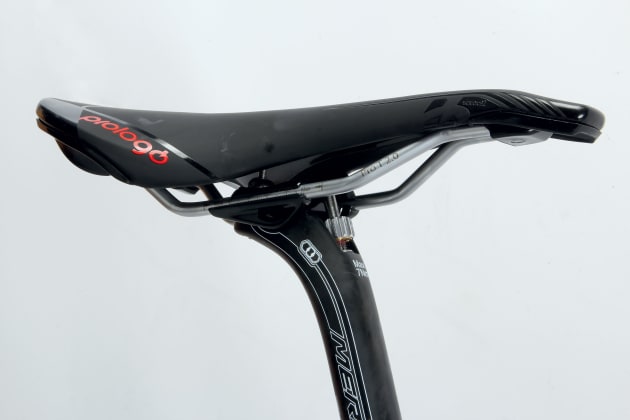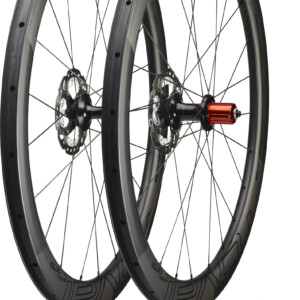A quick shout out and well wishes to my fellow Bicycling Australia reviewer Pat Howard as this was intended to be his review. Unfortunately Pat had an unscheduled meeting with the bitumen and a broken collarbone prevented him from throwing a leg over this latest test bike. Due to Pat’s incapacitation I had to drive over and pick up the bike from him, not knowing what I was going to be riding. As we met up, my gaze was centred more on Pat’s injuries and also keeping one eye out for Sydney’s notorious parking police such that it wasn’t till I was wheeling the bike away to my car that I realised what I was to be riding. At first glance the Merida looks like a racing bike should; slender lines, an aggressive stance, Di2 groupset and disc brakes. Wait!! What?? Disc Brakes??

Often it is such that disc brakes become the glaring focal point of any new bike, and as someone from the “old school” I often find this visually assaulting, like seeing Miranda Kerr walking up the beach wearing Crocs. However the Merida so impressed me with its other attributes that the disc brakes for once were not the centre of attention. The next thing of note when loading the Merida into my car was the weight, or lack of it. For an Ultegra spec bike with disc brakes the Scultura felt pretty light, and at home the scales had it coming in at 7.7kgs which for a “large” frame with disc brakes is mighty impressive. The reason for this is that it is based very closely on Merida’s standard Scultura 7000 frame. The Scultura is Merida’s road frame come climbing frame which in reality means it is a super lightweight production road racing bike. Merida’s long association with Team Lampre has meant that their developments have been squarely aimed at being up to Pro Team standard and the Scultura has been the team’s choice whenever the roads tend skyward. Merida’s Scultura frames are among the lightest in the pro peloton and it is that technology that has allowed the Scultura Disc 7000 to still be a lightweight even while carrying the slight penalty of disc brakes.
As mentioned at the start, this wasn’t intended to be my ride, and to be honest if anything it was probably a tad big for me, given my choice I would have preferred the 54 over the 56 but that is more about my weird geometry not the Scultura’s. In saying that though, the Merida was still easy to handle. Being a race bred bike and having to reach a little further than normal I was expecting the Scultura to be twitchy, but it was more than accommodating possibly due to the wheelbase being slightly longer than its rim braked brother or simply due to some fine engineering. Merida are one of the world’s largest carbon frame manufacturers so if anyone is to be trusted to make a quality lightweight frameset, these guys are in the box seat.

In profile, in comparison to many current bikes the Scultura doesn’t present any super-sized tube sections. For the most part from side on the Scultura cuts a lithe figure befitting its weight. The head tube, in fact, is the stand out when looking for junctions. It blends seamlessly into a fork that belies the fact that it has been built to accommodate an internally routed hydraulic cable. The downtube while still looking normal in profile, when viewed from above reveals a large horizontal section that wraps around the seat tube and flows through to the Scultura’s “Flex Stay” seat stays.
While I know looks are a subjective thing I’d really like to give a big ‘fist bump’ to the design team that worked on the Scultura 7000. The colour scheme is very much to my liking. The predominantly black on black scheme gives it a svelte, stealthy look, the red accents give it a splash of colour without being gaudy and the colour coded bar tape rounds off the ensemble nicely.

The groupset on the Scultura is Shimano’s great value, ultra-reliable workhorse Ultegra Di2. A groupset whose only real downfall is that it is so good that many people cannot see the need to stump up the extra dollars for Dura-Ace. The crankset is a 175mm which, while that is fine for those at the taller end of the ‘large’ scale is a tad long for those of us on the cusp of smaller sizes. The wheelset is smooth rolling as you would expect and although they give the appearance of being a bit on the harsh side, in combination with the 25mm Continental tyres the ride is a lot smoother than I expected. The braking of course is the reason for this bike being. I’m starting to come around to thinking that disc brake road bikes are actually the way forward. The quality, consistency and power of these Shimano stoppers combined with the fact that the Pro Teams are already on disc brakes shows they really are the real deal. For mine the only gripe I have with hydraulic disc brakes is the length of the lever travel which, as someone who is pedantic about having his wheels true, his brakes snug and his levers firm takes a little getting used to but a small cost for such quality braking.
The Scultura is Merida’s race bike and that is evident in the way it rides. It is quick off the mark and continues to accelerate as long as the legs hold out. Disc braking allows the brake bridge to be removed from the seatstays, freeing up the rear end to give better shock absorption. When it comes to evaluating climbing specific frames I’m probably not the best qualified, gravity isn’t my friend, however carrying a few extra pounds I appreciate a light bike. My idea of climbing is trying to punch over any lumps as quickly as I can which while not technically climbing does give me a chance to evaluate the stiffness of the Scultura frame.

My nearest decent hill is quite a few k’s away from home so for me a hilly ride defaults to a long ride as well. The flex stay seat stays do what they promise and take the edge of harsh surfaces and the unexpected thuds that sneak up on you during high speed descents. The Scultura also handles high speed corners with ease, carving clean lines and rewarding bravery. This is just as well as there is no point having a bike that can get you to the top of the hill in record time if it can’t get you back down safely and the confidence of consistent braking combined with dependable handling allows you to do just that.
While until now many of the disc brake offerings I have ridden have been ‘disc brake bikes you could race’ the Merida Scultura 7000 really is a race bike with disc brakes. Now if the UCI would just get with the program.

Summing Up:
Quality
The Scultura is a race proven, lightweight frame which, in conjunction with Shimano’s Ultegra Di2 shifting and hydraulic brakes and teamed with some smooth DT Swiss wheels makes the Scultura 7000 a compelling and more than respectable package. Of the disc braked road bikes I’ve had the pleasure to ride, I’d currently rank this as one of the best.
Performance
If pro teams are riding this technology then there is little for the rest of us to complain about. The only reason for you not winning races on this bike is the UCI’s silly rules. Stiff enough for all but the biggest gorilla yet light enough to allow you an extra guilt free muffin at your next coffee stop, with ultra-reliable electronic shifting.
Value for money
At $5,299 the Scultura 7000 is right on par for its specification list and groupset. However when you factor in the lightweight nature of this great little frame if this is around your budget then the Scultura should be high on your shopping list.
Overall
The Scultura makes me want to petition the UCI to get its finger out and allow us to race quality bikes like the Merida with the best brakes available. In fact, while until now I’ve been sitting firmly on the fence, if the Scultura 7000 is the sign of things to come with disc brakes, I’d be happy to have the Scultura 7000 as my everyday bike and resign my rim brake bike to race day duties until the UCI comes to their senses.

Specifications
Frame: Scultura Carbon
Fork: Scultura Carbon
Head Set: FSA integrated
Stem: Merida Expert
Handlebars: Merida Expert Compact
Saddle: Prologo Scratch
Seat post: Merida EGM Carbon
Shifters: Shimano Road Disc Di2
Brakes: Shimano RS805
Front derailleur: Shimano Ultegra Di2
Rear Derailleur: Shimano Ultegra Di2
Cassette: Shimano Ultegra 11-28
Chain: KMC X11EL
Crank: Shimano Ultegra, 50-34, 175mm
Bottom Bracket: Shimano Pressfit
Wheels: DT Swiss R23
Tyres: Continental Grand Sport Race 25
Weight: 7.7kg (large)
Price: $5,299
Distributor: www.advancetraders.com.au


